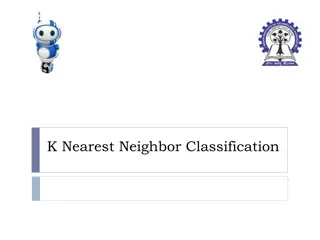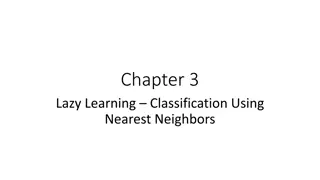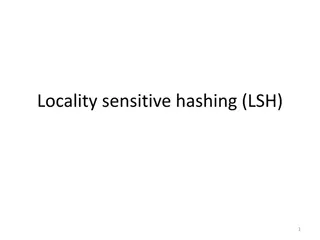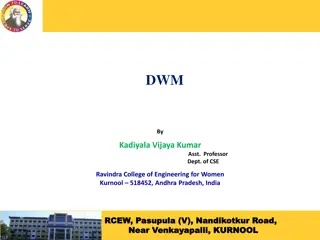Machine Learning Techniques: K-Nearest Neighbour, K-fold Cross Validation, and K-Means Clustering
This lecture covers important machine learning techniques such as K-Nearest Neighbour, K-fold Cross Validation, and K-Means Clustering. It delves into the concepts of Nearest Neighbour method, distance measures, similarity measures, dataset classification using the Iris dataset, and practical applications in classification tasks. The content explains the working of K-Nearest Neighbour method, leaves one out cross-validation, and the comparison between k-fold cross-validation and validation set. It also discusses the Nearest Neighbour method in detail, how to find the nearest neighbors, and distance measures.
Download Presentation

Please find below an Image/Link to download the presentation.
The content on the website is provided AS IS for your information and personal use only. It may not be sold, licensed, or shared on other websites without obtaining consent from the author.If you encounter any issues during the download, it is possible that the publisher has removed the file from their server.
You are allowed to download the files provided on this website for personal or commercial use, subject to the condition that they are used lawfully. All files are the property of their respective owners.
The content on the website is provided AS IS for your information and personal use only. It may not be sold, licensed, or shared on other websites without obtaining consent from the author.
E N D
Presentation Transcript
COMP 307 Lecture 05 Machine Learning 2 3-K Techniques: K-Nearest Neighbour, K-fold Cross Validation and K-Means Clustering Dr Bing Xue bing.xue@ecs.vuw.ac.nz
COMP307 2 ML2(3-K Technique): Outline Nearest neighbour method - Basic nearest neighbour method - K-Neighbour method - Distance measure/Similarity measure K-fold cross validation - Leave-one out cross validation - k-fold cross validation vs validation set K-means clustering
COMP307 3 ML2(3-K Technique): Dataset (Classification) Iris Dataset: @Iris: 5.1,3.5,1.4,0.2, Iris-setosa 4.9,3.0,1.4,0.2, Iris-setosa 4.7,3.2,1.3,0.2, Iris-setosa 4.6,3.1,1.5,0.2, Iris-setosa 5.0,3.6,1.4,0.2, Iris-setosa . . 7.0,3.2,4.7,1.4, Iris-versicolor 6.4,3.2,4.5,1.5, Iris-versicolor 6.9,3.1,4.9,1.5, Iris-versicolor 5.5,2.3,4.0,1.3, Iris-versicolor 6.5,2.8,4.6,1.5, Iris-versicolor . . 6.3,3.3,6.0,2.5, Iris-virginica 5.8,2.7,5.1,1.9, Iris-virginica 7.1,3.0,5.9,2.1, Iris-virginica 6.3,2.9,5.6,1.8, Iris-virginica . . 150 examples/ instances/ observations/objects - Each instance is represented as a feature vector and a desired/target class label 3 classes: Iris-Setosa, Iris-Versicolor, Iris-Virginica 4 features/variables/attributes: - sepal length in cm - sepal width in cm - petal length in cm - petal width in cm
COMP307 4 ML2(3-K Technique): Nearest Neighbour Given a training set with a number of instances Nearest neighbour method - Each unseen instance (in the test set) is compared with all the instances in the training set - Find the nearest neighbour (instance) from the training set - the unseen instance is classified as the class of the nearest neighbour @Iris: 5.1,3.5,1.4,0.2, Iris-setosa 4.9,3.0,1.4,0.2, Iris-setosa . . 7.0,3.2,4.7,1.4, Iris-versicolor 6.4,3.2,4.5,1.5, Iris-versicolor 6.3,3.3,6.0,2.5, Iris-virginica 5.8,2.7,5.1,1.9, Iris-virginica
COMP307 5 ML2(3-K Technique): K-Nearest Neighbour K-Nearest Neighbour method: - Similar to the nearest neighbour method - But find k nearest instances from the training set - Then choose the majority class as the class label of the unseen instance But how to find the nearest neighbours?
COMP307 6 ML2(3-K Technique): Nearest Neighbour Distance Measures Given two feature vectors with numeric values A=(a 1 ,a 2 ,...,a n )andB=(b 1 ,b 2 ,...,b n ) COMP307 Whatproblemcanyoufind? The(k-)nearestneighbourmethodissimple,easytouse,and Usethedistancemeasure: Giventwofeaturevectorswithnumericvalues canachievegoodresultsinmanycases R i istherangeoftheithcomponent Efficient? Doesthismethodexplicitlylearnaclassifier?Ifyes,whatisit? NearestNeighbour DistanceMeasures d= i=1 R 2 i n (a i b i ) 2 = (a 1 b 1 ) R 2 1 + R 2 2 +...+ R 2 n 2 (a 2 b 2 ) 2 (a n b n ) 2 ML2(3-Ktechniques):4 Use the distance measure: R i istherangeoftheithcomponent COMP307 Whatproblemcanyoufind? The(k-)nearestneighbourmethodissimple,easytouse,and Usethedistancemeasure: Giventwofeaturevectorswithnumericvalues canachievegoodresultsinmanycases Efficient? Doesthismethodexplicitlylearnaclassifier?Ifyes,whatisit? NearestNeighbour DistanceMeasures d= i=1 R 2 i n (a i b i ) 2 = (a 1 b 1 ) R 2 1 + R 2 2 +...+ R 2 n A=(a 1 ,a 2 ,...,a n )andB=(b 1 ,b 2 ,...,b n ) 2 (a 2 b 2 ) 2 (a n b n ) 2 ML2(3-Ktechniques):4 Ri is the range of the ith component The (k-)nearest neighbour method is simple, easy to use, and can achieve good results in many cases What problem can you find? - Does this method explicitly learn a classifier? If yes, what is it? - Efficient?
COMP307 7 ML2(3-K Technique): K-fold Cross Validation Idea: chop the available data into K equal chunks For each chunk in turn: - Treat it as the test data set - Treat the rest K 1 chunks as the training data set - The classifier trained/learned from the training set is applied to the test set The process is then repeated K times (the folds), with each of the K chunks used exactly once as the test data set. The K results from the folds can be then averaged (or otherwise combined) to produce a single estimation. Can be used for comparing two algorithms, or measure the performance of a particular algorithm when the data set is small.
COMP307 8 ML2(3-K Technique): 10-fold Cross Validation Example: 150 instances for 10-fold cross validation - Splitting into 10 chunks 15, 15, 15, 15, 15, 15, 15, 15, 15, 15 training set test set
COMP307 9 ML2(3-K Technique): Leave-one-out Cross Validation It is very similar to the K-fold cross-validation method Every time, it only uses one instance as the test data set The process needs to be repeated m times, where m is the total number of examples/instances in the entire data set K-fold cross validation (including leave-one-out cross validation) is NOT a machine learning or classification method or technique It is an experimental design method for setting up experiments for supervised learning tasks such as classification and regression
COMP307 10 ML2(3-K Technique): Validation Set vs Cross Validation Validation set (vs training set vs test set) - The validation set is a data set - Validation set is a separate data set from the training set and the test set. - Validation set is used for monitoring the training process but is not directly used for learning the classifier - the validation set is used for avoid overfitting or overtraining - Assume: 100 examples 50 vs 50 40 vs 30 vs 30 Cross Validation - Is a experimental design method, NOT a data set - In this method, there are only training sets and test sets - No validation set exists Data Subset vs How to Use Data
COMP307 11 ML2(3-K Technique): K-Means Clustering Unlabelled data Expect to obtain good partitions for the instances using learning techniques. Need clustering techniques, unsupervised learning K-means clustering is a method of cluster analysis which aims to partition m instances into k clusters in which each instance belongs to the cluster with the nearest mean. Need some kind of distance measure such as Euclidean distance Need to assume the number of clusters
COMP307 12 ML2(3-K Technique): K-Means Clustering: Algorithm 1. Set k initial means (in this case k=3) randomly from the data set (shown in color). 2. Create k clusters by associating every instance with the nearest mean based on a distance measure. 3. Replace the old means with the centroid of each of the k clusters (as the new means). 4. Repeat the above two steps until convergence (no change in each cluster center).
COMP307 13 ML2(3-K Technique): K-Means Clustering: An Example COMP307 K-MeansClustering: An Example (1) (3) ML2(3-K techniques): 11 (4) (2) K-means Algorithm Demo: https://www.youtube.com/watch?v=zHbxbb2ye3E
COMP307 14 ML2(3-K Technique): Summary Nearest neighbour method for classification - K-Nearest neighbour method classification method - Measures of comparing two feature vectors K-fold cross validation - experimental design method, NOT a learning method - validation set is a data set, NOT a method K-means method - clustering method, NOT for classification Next Lecture: Decision tree learning for classification Suggested reading: Section 18.3 (both 2nd and 3rd editions) and online materials























